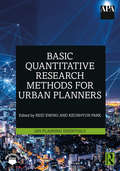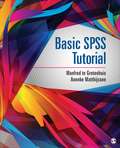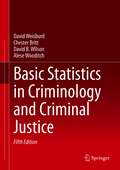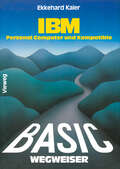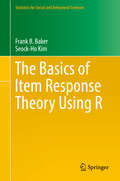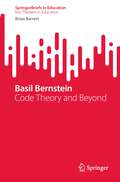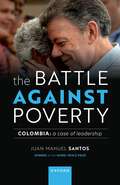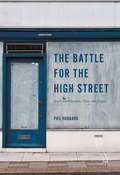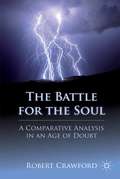- Table View
- List View
Basic Quantitative Research Methods for Urban Planners (APA Planning Essentials)
by Reid Ewing Keunhyun ParkIn most planning practice and research, planners work with quantitative data. By summarizing, analyzing, and presenting data, planners create stories and narratives that explain various planning issues. Particularly, in the era of big data and data mining, there is a stronger demand in planning practice and research to increase capacity for data-driven storytelling. Basic Quantitative Research Methods for Urban Planners provides readers with comprehensive knowledge and hands-on techniques for a variety of quantitative research studies, from descriptive statistics to commonly used inferential statistics. It covers statistical methods from chi-square through logistic regression and also quasi-experimental studies. At the same time, the book provides fundamental knowledge about research in general, such as planning data sources and uses, conceptual frameworks, and technical writing. The book presents relatively complex material in the simplest and clearest way possible, and through the use of real world planning examples, makes the theoretical and abstract content of each chapter as tangible as possible. It will be invaluable to students and novice researchers from planning programs, intermediate researchers who want to branch out methodologically, practicing planners who need to conduct basic analyses with planning data, and anyone who consumes the research of others and needs to judge its validity and reliability.
Basic Quantitative Research Methods for Urban Planners (APA Planning Essentials)
by Reid Ewing Keunhyun ParkIn most planning practice and research, planners work with quantitative data. By summarizing, analyzing, and presenting data, planners create stories and narratives that explain various planning issues. Particularly, in the era of big data and data mining, there is a stronger demand in planning practice and research to increase capacity for data-driven storytelling. Basic Quantitative Research Methods for Urban Planners provides readers with comprehensive knowledge and hands-on techniques for a variety of quantitative research studies, from descriptive statistics to commonly used inferential statistics. It covers statistical methods from chi-square through logistic regression and also quasi-experimental studies. At the same time, the book provides fundamental knowledge about research in general, such as planning data sources and uses, conceptual frameworks, and technical writing. The book presents relatively complex material in the simplest and clearest way possible, and through the use of real world planning examples, makes the theoretical and abstract content of each chapter as tangible as possible. It will be invaluable to students and novice researchers from planning programs, intermediate researchers who want to branch out methodologically, practicing planners who need to conduct basic analyses with planning data, and anyone who consumes the research of others and needs to judge its validity and reliability.
Basic Sciences and Development: Rethinking Donor Policy (Routledge Revivals)
by Martha J. Garrett Claes G. GranqvistFirst published in 1998. In the Third World, development-orientated research in the basic sciences have received a negligible share of available resources from domestic and foreign sources. This book addresses the growing concerns regarding the policies guiding support to development research in recipient countries.
Basic Sciences and Development: Rethinking Donor Policy (Routledge Revivals)
by Martha J. Garrett, Claes G. Granqvist, Berhanu M. Abegaz, Ivan Chambouleyron, Jacques Gaillard, Demissu Gemeda, Mohamed Hag Ali Hassan, Nguyen Van Hieu, Narciso Matos, Jan S. Nilsson, Govindarajan Padmanaban, Stig Strömholm and Erik W. ThulstrupFirst published in 1998. In the Third World, development-orientated research in the basic sciences have received a negligible share of available resources from domestic and foreign sources. This book addresses the growing concerns regarding the policies guiding support to development research in recipient countries.
Basic Social Policy and Planning: Strategies and Practice Methods
by Hobart A BurchIn Basic Social Policy and Planning, Burch presents a generic process for professional intervention and social work leadership that is required of those who desire to achieve improvements in the lives of those they serve. Burch developed this text and guide so that even persons with no prior formal training in social planning can apply these principles in their practices. Because few social workers are content with simply repairing the damages caused by inequities, inadequacies, and injustices in society, Basic Social Policy and Planning offers a usable set of guidelines on how to change lives for the better, in small and occasionally large ways, from within any setting--agency, community, and public policy.Social workers, nurses, teachers, and other human service professionals spend their lives relating to the social and emotional needs and problems of people. Burch converts sophisticated policy and planning concepts and techniques into a form which experts and non-experts can understand, relate to, and apply in their practices. He supplies these workers with approaches, methods, models, ways of thinking, and techniques for planning. He covers: VIBES (Values, Interests, Beliefs, Ethics, and Slants): Understanding where you and others are coming from and toward what destination you and they are heading Systems theories and worldviews: Understanding how these affect planning Logical analysis of all ways of thinking--scientific and experiential, bounded and nonbounded Different approaches to planning--comprehensive rational analysis; disjointed incrementalism and satisficing; mixed scanning; strategic, decentralized, contingency, transactional, and advocacy planning Global, strategic, tactical, and project management levels of planning Needs assessment and participation of those who will be affected Quantitative and economic planning approaches: Understanding basic ideology and assumptions Quantitative and economic approaches--measurement, pricing, cost-effectiveness and cost-benefit analysis, decision analysisWhen used as a text, the first priority of this book is to give BSW and MSW students the training which they will need and want later in their careers. This training is consistent with Council on Social Work Education’s required BSW/MSW foundation courses as well as advance practice courses in most programs. When used as a guidebook for the many practitioners who have learned, since graduation, that they need more skill in setting and achieving policy, agency, and community goals than they learned in school, Basic Social Policy and Planning can enhance the “left brain” in social workers, who as a group tend to be stronger in the “right brain” direction with chapters that walk the reader step-by-step through a generic rational planning model and tell why, whom, when, and how to involve others in planning. Because the substance of the book is rooted in advance interdisciplinary planning theory and practice, this book is just what the doctor ordered for a doctoral first course in policy and planning--it provides the “hard” background in planning for professors of policy and macro practice. It is also highly appropriate for new PhDs who are assigned to teach such courses with limited background with its chapters on foundations of policy and planning, various approaches to planning, and quantitative techniques related to costs, benefits, and uncertainties in planning.
Basic Social Policy and Planning: Strategies and Practice Methods
by Hobart A BurchIn Basic Social Policy and Planning, Burch presents a generic process for professional intervention and social work leadership that is required of those who desire to achieve improvements in the lives of those they serve. Burch developed this text and guide so that even persons with no prior formal training in social planning can apply these principles in their practices. Because few social workers are content with simply repairing the damages caused by inequities, inadequacies, and injustices in society, Basic Social Policy and Planning offers a usable set of guidelines on how to change lives for the better, in small and occasionally large ways, from within any setting--agency, community, and public policy.Social workers, nurses, teachers, and other human service professionals spend their lives relating to the social and emotional needs and problems of people. Burch converts sophisticated policy and planning concepts and techniques into a form which experts and non-experts can understand, relate to, and apply in their practices. He supplies these workers with approaches, methods, models, ways of thinking, and techniques for planning. He covers: VIBES (Values, Interests, Beliefs, Ethics, and Slants): Understanding where you and others are coming from and toward what destination you and they are heading Systems theories and worldviews: Understanding how these affect planning Logical analysis of all ways of thinking--scientific and experiential, bounded and nonbounded Different approaches to planning--comprehensive rational analysis; disjointed incrementalism and satisficing; mixed scanning; strategic, decentralized, contingency, transactional, and advocacy planning Global, strategic, tactical, and project management levels of planning Needs assessment and participation of those who will be affected Quantitative and economic planning approaches: Understanding basic ideology and assumptions Quantitative and economic approaches--measurement, pricing, cost-effectiveness and cost-benefit analysis, decision analysisWhen used as a text, the first priority of this book is to give BSW and MSW students the training which they will need and want later in their careers. This training is consistent with Council on Social Work Education’s required BSW/MSW foundation courses as well as advance practice courses in most programs. When used as a guidebook for the many practitioners who have learned, since graduation, that they need more skill in setting and achieving policy, agency, and community goals than they learned in school, Basic Social Policy and Planning can enhance the “left brain” in social workers, who as a group tend to be stronger in the “right brain” direction with chapters that walk the reader step-by-step through a generic rational planning model and tell why, whom, when, and how to involve others in planning. Because the substance of the book is rooted in advance interdisciplinary planning theory and practice, this book is just what the doctor ordered for a doctoral first course in policy and planning--it provides the “hard” background in planning for professors of policy and macro practice. It is also highly appropriate for new PhDs who are assigned to teach such courses with limited background with its chapters on foundations of policy and planning, various approaches to planning, and quantitative techniques related to costs, benefits, and uncertainties in planning.
Basic SPSS Tutorial (PDF)
by Manfred Grotenhuis Anneke MatthijssenThis supplementary book for the social, behavioral, and health sciences helps readers with no prior knowledge of IBM® SPSS® Statistics, statistics, or mathematics learn the basics of SPSS. Designed to reduce fear and build confidence, Basic SPSS Tutorial by Manfred te Grotenhuis and Anneke Matthijssen guides readers through point-and-click sequences using clear examples from real scientific research and invites them to replicate the findings. Relevant outcomes are provided for reference, and exercises at the end of Chapters 2 – 5 provide additional practice. After reading the book and using the program, readers will come away with a basic knowledge of the most commonly used procedures in statistics.
Basic Statistics in Criminology and Criminal Justice: Volume 1
by David Weisburd Chester Britt David B. Wilson Alese WooditchThis introductory textbook takes a building-block approach that emphasizes the application and interpretation of statistics in research in crime and justice. This text is meant for both students and professionals who want to gain a basic understanding of common statistical methods used in criminology and criminal justice before advancing to more complex statistical analyses in future volumes. This book emphasizes comprehension and interpretation. As the statistical methods discussed become more complex and demanding to compute, it integrates statistical software. It provides readers with an accessible understanding of popular statistical programs used to examine real-life crime and justice problems (including SPSS, Stata, and R). In addition, the book includes supplemental resources such as a glossary of key terms, practice questions, and sample data. Basic Statistics in Criminology and Criminal Justice aims to give students and researchers a core understanding of statistical concepts and methods that will leave them with the confidence and tools to tackle the statistical problems in their own research work.
Basics der Existenzgründung in der Kultur- und Kreativwirtschaft: Praxis Kulturmanagement (essentials)
by Andrea HausmannDieses essential fokussiert gründer- und marktbezogene Herausforderungen selbstständiger bzw. unternehmerischer Tätigkeit in der Kultur- und Kreativwirtschaft. Dazu werden einführend charakteristische Merkmale der Branche beschrieben sowie zentrale Begriffe und Planungsinstrumente erläutert. Im Weiteren wird der Fokus auf die Gründerperson(en) sowie auf mögliche Arten der Realisierung von Gründungsvorhaben in der KKW gelegt. Ein weiteres Kapitel beschäftigt sich mit zentralen marktbezogenen Entscheidungen, wie z. B. den Möglichkeiten zur Identifizierung einer Geschäftsidee und der Notwendigkeit, dass diese Idee zur Lösung eines auf Seiten der Nachfrage relevanten Problems beiträgt. Auch die Kundenstruktur in der KKW und daraus resultierende Konsequenzen für das B2B- und B2C-Marketing werden beleuchtet.Die Autorin:Prof. Dr. Andrea Hausmann ist Professorin am Institut für Kulturmanagement der Pädagogischen Hochschule Ludwigsburg und verfügt über praktische Erfahrung aus eigener Gründungstätigkeit.
The BASICS Lean Implementation Model: Lean Tools to Drive Daily Innovation and Increased Profitability
by Charles W. Protzman III Daniel Protzman William KeenIn 2004 Charlie Protzman created The BASICS Lean Implementation Model, which covers the full spectrum of what is needed to be effective and successful at implementing a Lean System. The reader is taken through a step by step approach developed over the last 15 years, in the use and understanding of Lean tools, principles, and processes. The authors break down Lean concepts to their simplest terms to make everything as clear as possible for Lean practitioners. You will learn an integrated, structured, problem-solving approach identified by the acronym BASICS (Baseline, Analyze, Suggest Solutions, Implement, Check and Sustain). This methodology is combined with a proven business strategy to help ensure a successful and sustainable transformation of any organization. The BASICS approach produces "real" bottom line savings with 20% to 50% or more increases in productivity when compared to pure batching environments. As those who have read the book will tell you, this is not a theory book… but rather a book you can return to over and over again for reference, throughout your Lean journey.
The BASICS Lean Implementation Model: Lean Tools to Drive Daily Innovation and Increased Profitability
by Charles W. Protzman III Daniel Protzman William KeenIn 2004 Charlie Protzman created The BASICS Lean Implementation Model, which covers the full spectrum of what is needed to be effective and successful at implementing a Lean System. The reader is taken through a step by step approach developed over the last 15 years, in the use and understanding of Lean tools, principles, and processes. The authors break down Lean concepts to their simplest terms to make everything as clear as possible for Lean practitioners. You will learn an integrated, structured, problem-solving approach identified by the acronym BASICS (Baseline, Analyze, Suggest Solutions, Implement, Check and Sustain). This methodology is combined with a proven business strategy to help ensure a successful and sustainable transformation of any organization. The BASICS approach produces "real" bottom line savings with 20% to 50% or more increases in productivity when compared to pure batching environments. As those who have read the book will tell you, this is not a theory book… but rather a book you can return to over and over again for reference, throughout your Lean journey.
Basics Marketing 01: Consumer Behaviour (Basics Marketing)
by Hayden NoelBasics Marketing 01: Consumer Behaviour examines the relationship between consumers and culture, and the impact of current trends on consumer behaviour. It explores the different ways in which consumers around the world respond to marketing strategies, examining the interpretation of new stimuli using existing knowledge, and how both new and remembered knowledge combine to influence purchasing behaviour.Finally, there is a detailed examination of the influence of ethnicity, religion, class, age and gender on consumers' actions and the importance of understanding the challenges and diversity of a global marketplace.
Basics Marketing 01: Consumer Behaviour (Basics Marketing)
by Hayden NoelBasics Marketing 01: Consumer Behaviour examines the relationship between consumers and culture, and the impact of current trends on consumer behaviour. It explores the different ways in which consumers around the world respond to marketing strategies, examining the interpretation of new stimuli using existing knowledge, and how both new and remembered knowledge combine to influence purchasing behaviour.Finally, there is a detailed examination of the influence of ethnicity, religion, class, age and gender on consumers' actions and the importance of understanding the challenges and diversity of a global marketplace.
The Basics of Item Response Theory Using R (Statistics for Social and Behavioral Sciences)
by Frank B. Baker Seock-Ho KimThis graduate-level textbook is a tutorial for item response theory that covers both the basics of item response theory and the use of R for preparing graphical presentation in writings about the theory. Item response theory has become one of the most powerful tools used in test construction, yet one of the barriers to learning and applying it is the considerable amount of sophisticated computational effort required to illustrate even the simplest concepts. This text provides the reader access to the basic concepts of item response theory freed of the tedious underlying calculations. It is intended for those who possess limited knowledge of educational measurement and psychometrics.Rather than presenting the full scope of item response theory, this textbook is concise and practical and presents basic concepts without becoming enmeshed in underlying mathematical and computational complexities. Clearly written text and succinct R code allow anyone familiar with statistical concepts to explore and apply item response theory in a practical way. In addition to students of educational measurement, this text will be valuable to measurement specialists working in testing programs at any level and who need an understanding of item response theory in order to evaluate its potential in their settings.
Basil Bernstein: Code Theory and Beyond (SpringerBriefs in Education)
by Brian BarrettThis book provides an accessible way into the ideas of Basil Bernstein. It introduces, explains and exemplifies key conceptual landmarks in the development of his theory, from his sociolinguistics in the 1960s through analyses of classrooms and the construction of curriculum in the 1970s and 1980s, to studies of intellectual fields of research through the 1990s. The book introduces how these ideas can and have been used in empirical research over the past fifty years, and how they are being built on by scholars in the twenty-first century to create a cumulative approach to understanding education, knowledge and society that is alive and growing today.
Basiswissen Energieinformatik: Ein Lehr- und Arbeitsbuch für Studierende und Anwender
by Alexander StuckenholzDie digitale Datenverarbeitung ist aus dem Lebensalltag der Energieunternehmen heute nicht mehr wegzudenken. Sowohl bei der Organisation des physikalisch-technischen als auch des kaufmännischen Energieflusses spielt der Einsatz moderner Informations- und Kommunikationssysteme eine tragende Rolle. Konzepte wie das Smart Grid, virtuelle Kraftwerke oder regionale Energiehandelsmärkte sind ohne die digitale Datenverarbeitung nicht umzusetzen. Die Anwendung der Informations- und Kommunikationstechnik in der Energiewirtschaft mündet dabei in die sogenannte Energieinformatik, in der domänenspezifische Informationsmodelle, Kommunikationsstandards sowie Protokolle und Prozesse Verwendung finden. Dieses Lehr- und Arbeitsbuches bietet eine erste Einführung in die Informationsverarbeitung im Bereich der deutschen Energiewirtschaft. Es richtet sich gleichermaßen an Studierende und Anwender aus den Bereichen Informatik, Energietechnik und -wirtschaft.
Basketball in Japan: Shooting for the Stars (Routledge Contemporary Japan Series)
by Aaron L. MillerThrough a study of basketball in Japan, this book aims to help readers better understand the historical formation and contemporary reformation of cultural identity in Japan.This reformation includes the process of reconciling the perceived differences between basketball in Japan and basketball in the West, the process of reconciling how perceptions of one’s body are shaped in a globally interconnected society, the process of reconciling what it means to be a modern man, and the process of reconciling what it means to be Japanese in a nation that is increasingly multicultural. In other words, basketball in Japan matters, not only because it has for too long been over‑simply labelled as a “minor” sport, but also because it is much more than a game.Examining the real and symbolic power which sport has on Japanese culture, and even in some instances the state, this book will be a valuable resource for scholars and students of Japanese culture and society and the sociology of sports.
Basketball in Japan: Shooting for the Stars (Routledge Contemporary Japan Series)
by Aaron L. MillerThrough a study of basketball in Japan, this book aims to help readers better understand the historical formation and contemporary reformation of cultural identity in Japan.This reformation includes the process of reconciling the perceived differences between basketball in Japan and basketball in the West, the process of reconciling how perceptions of one’s body are shaped in a globally interconnected society, the process of reconciling what it means to be a modern man, and the process of reconciling what it means to be Japanese in a nation that is increasingly multicultural. In other words, basketball in Japan matters, not only because it has for too long been over‑simply labelled as a “minor” sport, but also because it is much more than a game.Examining the real and symbolic power which sport has on Japanese culture, and even in some instances the state, this book will be a valuable resource for scholars and students of Japanese culture and society and the sociology of sports.
Bataille (Transitions)
by Fred Botting Scott WilsonOne of the most profound thinkers of the twentieth century, Georges Bataille has only recently come to prominence in the Anglophone academy, partly through the influence of post-structuralism. Once seen as no more than a philosopher of eroticism and a writer of avant-garde pornography, Bataille is emerging as an absolutely central figure to discussions of culture, economy, subjectivity and difference.Batailleis the first volume of its kind to offer lucid, diverse and relevant examples of the ways of reading literary and cultural texts in the light of Bataille's work. The essays explore the significance of Bataillean notions like heterology, general economy, transgression and eroticism, through detailed readings of Shakespearean, Elizabethan and Jacobean literature; in analyses of Gothic and postmodern fiction; and in critiques of popular culture, rock music and Hollywood movies. In order to make Bataillean notions more comprehensible to contemporary readers, his concepts are situated in relation to the ideas of renowned critical and cultural theorists like Baudrillard, Deleuze, Derrida, Kristeva, Lacan, as well as Hegel, Freud, Nietzsche and Marx. Here the influence of Bataille is outlined in intellectual and historical terms and the significance of his work can be seen for both contemporary and futural modes of cultural analysis.
Bataille (Transitions)
by Scott Wilson Fred BottingOne of the most profound thinkers of the twentieth century, Georges Bataille has only recently come to prominence in the Anglophone academy, partly through the influence of post-structuralism. Once seen as no more than a philosopher of eroticism and a writer of avant-garde pornography, Bataille is emerging as an absolutely central figure to discussions of culture, economy, subjectivity and difference.Bataille is the first volume of its kind to offer lucid, diverse and relevant examples of the ways of reading literary and cultural texts in the light of Bataille's work. The essays explore the significance of Bataillean notions like heterology, general economy, transgression and eroticism, through detailed readings of Shakespearean, Elizabethan and Jacobean literature; in analyses of Gothic and postmodern fiction; and in critiques of popular culture, rock music and Hollywood movies. In order to make Bataillean notions more comprehensible to contemporary readers, his concepts are situated in relation to the ideas of renowned critical and cultural theorists like Baudrillard, Deleuze, Derrida, Kristeva, Lacan, as well as Hegel, Freud, Nietzsche and Marx. Here the influence of Bataille is outlined in intellectual and historical terms and the significance of his work can be seen for both contemporary and futural modes of cultural analysis.
The Battle Against Poverty: Colombia: A Case of Leadership
by Mr Juan Manuel SantosIn the second decade of the 21st century, Colombia showed surprising results in the fight against poverty. Monetary poverty dropped, extreme monetary poverty was cut in half, and multidimensional poverty fell. More than five million Colombians overcame poverty. Inequality also decreased significantly. In the middle of an internal armed conflict and peace negotiations, Colombia became a poverty reduction success story. All of this happened under the leadership of President Juan Manuel Santos (2010-2018). How was this accomplished? In this important book, based on his experience and with data and statistics, former President Santos explains how this battle against poverty was waged and describes the tools, programs, and policies that produced these results. In particular, he emphasizes the importance of Colombia's globally pioneering adoption of the Multidimensional Poverty Index (MPI), calculated according to the Alkire-Foster method and developed at the Oxford Poverty and Human Development Initiative (OPHI). The MPI, inspired by the work of Professor Amartya Sen, has been used in Colombia not only as a poverty measure but also as an instrument to guide social policy. The Colombian approach to poverty offers lessons, clearly explained in this book, to other nations, academics, and decision-makers. The Colombian experience demonstrates that, with political leadership and reliable poverty measurement, it is possible to make progress toward social equality.
The Battle Against Poverty: Colombia: A Case of Leadership
by Mr Juan Manuel SantosIn the second decade of the 21st century, Colombia showed surprising results in the fight against poverty. Monetary poverty dropped, extreme monetary poverty was cut in half, and multidimensional poverty fell. More than five million Colombians overcame poverty. Inequality also decreased significantly. In the middle of an internal armed conflict and peace negotiations, Colombia became a poverty reduction success story. All of this happened under the leadership of President Juan Manuel Santos (2010-2018). How was this accomplished? In this important book, based on his experience and with data and statistics, former President Santos explains how this battle against poverty was waged and describes the tools, programs, and policies that produced these results. In particular, he emphasizes the importance of Colombia's globally pioneering adoption of the Multidimensional Poverty Index (MPI), calculated according to the Alkire-Foster method and developed at the Oxford Poverty and Human Development Initiative (OPHI). The MPI, inspired by the work of Professor Amartya Sen, has been used in Colombia not only as a poverty measure but also as an instrument to guide social policy. The Colombian approach to poverty offers lessons, clearly explained in this book, to other nations, academics, and decision-makers. The Colombian experience demonstrates that, with political leadership and reliable poverty measurement, it is possible to make progress toward social equality.
The Battle for the High Street: Retail Gentrification, Class and Disgust
by Phil HubbardThis book analyses the social and cultural status of high streets in the age of recession and austerity. High streets are shown to have long been regarded as the heart of many communities, but have declined to a state where boarded-up and vacant retail units are a familiar sight in many British cities. The book argues that the policies deemed necessary to revive the fortunes of high streets are often thinly-veiled attacks on the tastes and cultures of the working class. Policy-makers often promote boutiques, art galleries and upmarket cafés at the expense of some of the outlets frequented by less affluent populations, including betting shops, fast food takeaways, discount stores and bargain booze outlets. Highlighting the social and cultural roles that so-called 'dying' high streets continue to play in the lives of working class and disadvantaged populations, this book provides a powerful argument against retail gentrification, and a timely analysis of class conflict in austerity Britain. It will be of great interest to scholars of geography, social policy and cultural studies.
The Battle for the Soul: A Comparative Analysis in an Age of Doubt
by R. CrawfordDo we all possess a soul? If so, what is it? Can it be defined? Crawford argues that it is important that we have a soul because if it is immortal then we can hope for life after death. But some religions insist that it is the resurrection of the body which is vital.
